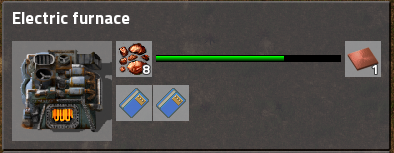Electric furnace: Difference between revisions
Jump to navigation
Jump to search
No edit summary |
m (→Interface) |
||
| Line 14: | Line 14: | ||
}} | }} | ||
== Interface == | == Interface == | ||
[[File:Electric_furnace.PNG | [[File:Electric_furnace.PNG|The interface of an electric furnace.]] | ||
'''Electric furnaces''' provide 2 module slots, which allow for more flexibility in special applications. The use of [[Electric network|electrical power]] eliminates the requirement for a [[Fuel]] supply chain, but at the cost of space. Electric furnaces are larger than [[Stone furnace|stone]] or [[Steel furnace|steel]] furnaces. | '''Electric furnaces''' provide 2 module slots, which allow for more flexibility in special applications. The use of [[Electric network|electrical power]] eliminates the requirement for a [[Fuel]] supply chain, but at the cost of space. Electric furnaces are larger than [[Stone furnace|stone]] or [[Steel furnace|steel]] furnaces. | ||
Revision as of 03:05, 23 August 2016
Interface
Electric furnaces provide 2 module slots, which allow for more flexibility in special applications. The use of electrical power eliminates the requirement for a Fuel supply chain, but at the cost of space. Electric furnaces are larger than stone or steel furnaces.
As electric furnaces consume a substantial amount of power, Efficiency modules are a good option. This is much more space-efficient than using Solar panels.
